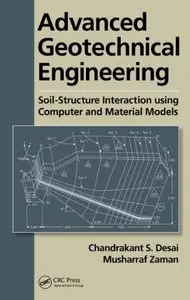Chandrakant S. Desai, Musharraf Zaman, "Advanced Geotechnical Engineering: Soil-Structure Interaction using Computer and Material Models"
English | ISBN: 1466515600 | 2014 | 638 pages | PDF | 90 MB
English | ISBN: 1466515600 | 2014 | 638 pages | PDF | 90 MB
Soil-structure interaction is an area of major importance in geotechnical engineering and geomechanics Advanced Geotechnical Engineering: Soil-Structure Interaction using Computer and Material Models covers computer and analytical methods for a number of geotechnical problems. It introduces the main factors important to the application of computer methods and constitutive models with emphasis on the behavior of soils, rocks, interfaces, and joints, vital for reliable and accurate solutions.
This book presents finite element (FE), finite difference (FD), and analytical methods and their applications by using computers, in conjunction with the use of appropriate constitutive models; they can provide realistic solutions for soil–structure problems. A part of this book is devoted to solving practical problems using hand calculations in addition to the use of computer methods. The book also introduces commercial computer codes as well as computer codes developed by the authors.
Uses simplified constitutive models such as linear and nonlinear elastic for resistance-displacement response in 1-D problems
Uses advanced constitutive models such as elasticplastic, continued yield plasticity and DSC for microstructural changes leading to microcracking, failure and liquefaction
Delves into the FE and FD methods for problems that are idealized as two-dimensional (2-D) and three-dimensional (3-D)
Covers the application for 3-D FE methods and an approximate procedure called multicomponent methods
Includes the application to a number of problems such as dams , slopes, piles, retaining (reinforced earth) structures, tunnels, pavements, seepage, consolidation, involving field measurements, shake table, and centrifuge tests
Discusses the effect of interface response on the behavior of geotechnical systems and liquefaction (considered as a microstructural instability)
This text is useful to practitioners, students, teachers, and researchers who have backgrounds in geotechnical, structural engineering, and basic mechanics courses.



